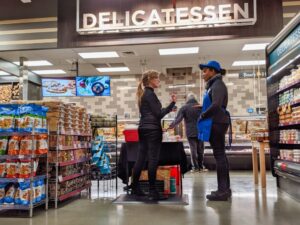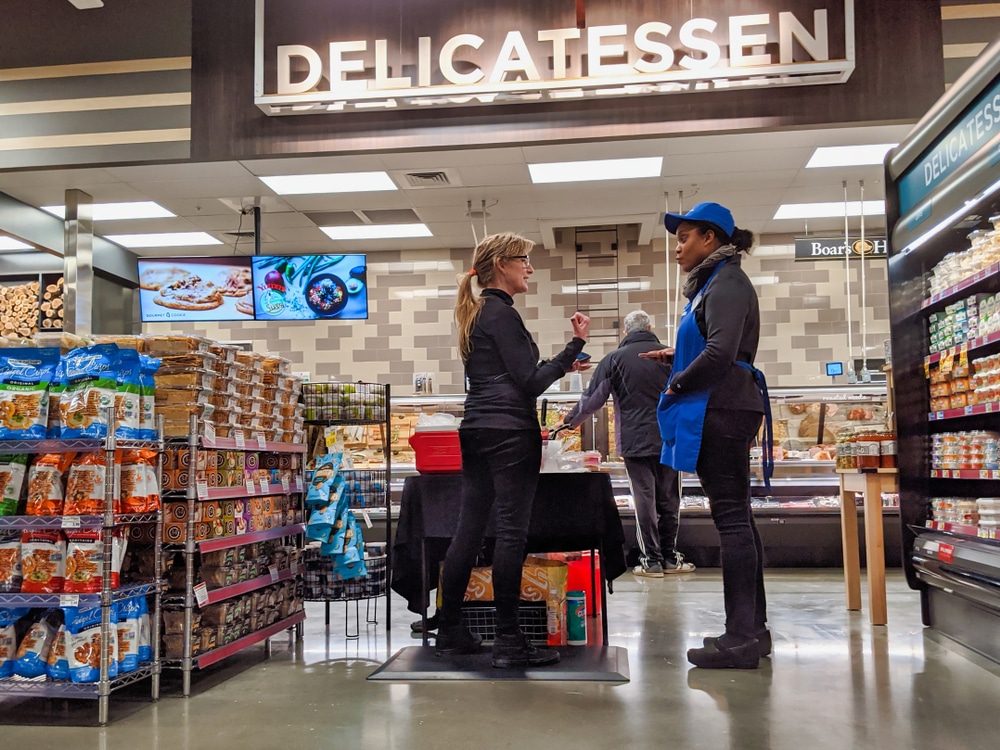Increasing market share can happen in one of two ways—either brands and retailers are “stealing” business from competitors or creating a new demand to increase the market along with share. Continue reading “How to increase market share in retail with mobile marketing”
Category: Full Funnel Marketing
Understanding how consumers interact with brands on the path to purchase
What makes a consumer purchase? Continue reading “Understanding how consumers interact with brands on the path to purchase”
Why the most effective immersive brand experiences feature mobile
The most effective immersive brand experiences are driven by digital technology—more specifically, mobile technology. Continue reading “Why the most effective immersive brand experiences feature mobile”
How to leverage in-store digital marketing to boost sales
In-store digital marketing in 2020 looks very different than in-store digital marketing even five years ago. Continue reading “How to leverage in-store digital marketing to boost sales”
How to build awareness of a new product with mobile marketing
If you’ve invested considerable time, effort, and finance into the development of a new product, it’s understandable that you can’t wait to show it off. Continue reading “How to build awareness of a new product with mobile marketing”
4 strategies to enhance the customer shopping experience in-store
“Strategy” refers to a high-level action plan designed to achieve one or more goals under conditions of uncertainty. There has been much uncertainty in brick-and-mortar retail these days, with customers shifting online and many longstanding retailers shuttering their doors for good in what the media has called a “retail apocalypse.” Yet, that doesn’t mean brands and retailers should throw up their hands in despair. Research suggests there is much value in shifting your focus to enhance the customer shopping experience in 2020.
What Is Customer Experience and Why Does It Matter in 2020?
Customer experience is your shoppers’ holistic perception of your brand. The in-store customer experience involves everything from helpful customer service representatives and short checkout wait times, to the type of music playing and aisle layout.
Recent statistics reveal:
- Companies earning $1 billion annually can expect an extra $700 million within three years of investing in customer experience.
- Eighty-six percent of shoppers say they’re willing to “pay more” for a great customer experience—which translates to a price premium of 13% to 18%.
- Personalized experiences have led 49% of buyers to make impulse purchases.
A Walker study estimates that customer experience will overtake price and product as the key brand differentiator by the end of 2020. So, really, it’s not a question of if you should invest in customer experience, but rather how.
4 Strategies to Enhance Customer Shopping Experience in 2020
You may consider a number of strategies to provide shoppers with a better in-store experience:
1. Reinvent Your Stores With Rotating Themes
Changing a store’s theme can be a headline-garnering way to create retail buzz. While most large department stores have given up their market shares to Walmart and Target, a few dominant players have stayed in the business by borrowing from the “pop-up shop” method of reinvention. For instance, Macy’s rolled out rotating STORY boutiques—“a retail concept that takes the point of view of a magazine, changes like a gallery, and sells things like a store.” Every six to eight weeks, the store design and inventory changes based on rotating themes like “Home for the Holidays” or “Beauty.” Bloomingdale’s takes a similar approach with rotating carousel pop-ups themed around culturally significant trends.
If you don’t have the budget to go all-out, your store “transformations” could be as simple as adding a few Instagram-worthy spaces. “These days, if consumers can’t Instagram a store, it’s almost not even worth going,” according to AdWeek. For instance, Morning Lavender Boutique and Café in Orange County, California created a breathtaking wall of flowers that invites shoppers to stop and snap a photo. Similarly, apparel retailer Showpo features a “social media nook”—a chic café set-up with a table, chairs, cakes, and tea accessories.
2. Turn Shopping at Your Store Into an Interactive Experience
People appreciate stores because they’re physical places of trial, discovery, and interaction. Stores like Trader Joe’s and Target employ the “wow factor” of free samples and dynamic displays to thrill their loyal customers in new ways. Marshall’s went so far as to hide curated “surprise boxes” around their stores for lucky shoppers to discover and claim. Shopkick, a mobile shopping rewards app, offers an even easier way to create an interactive experience for shoppers. Shopkick users are enticed to visit partnering stores and seek out products in exchange for reward points they can use towards gift cards of their choosing. The app’s scavenger hunt-like gamification provides shoppers with a fun way to discover new products.
3. Train Employees to Offer Excellent Customer Service
 Online shopping offers convenience, but it can’t yet deliver good, old-fashioned, face-to-face customer service. You can use this to your advantage by training your employees to interact with individual shoppers based on past purchase history. Employing data-capturing systems and arming employees with tablets allows for more personalized recommendations and truly helpful customer service. Reps can search inventory in real-time and tap into customer profiles to go over and beyond the competition. Better than Google is the store representative who knows the pros and cons of various products; which brands sell best; what will best meet certain needs; and where to find the precise items on the shopper’s list.
Online shopping offers convenience, but it can’t yet deliver good, old-fashioned, face-to-face customer service. You can use this to your advantage by training your employees to interact with individual shoppers based on past purchase history. Employing data-capturing systems and arming employees with tablets allows for more personalized recommendations and truly helpful customer service. Reps can search inventory in real-time and tap into customer profiles to go over and beyond the competition. Better than Google is the store representative who knows the pros and cons of various products; which brands sell best; what will best meet certain needs; and where to find the precise items on the shopper’s list.
One example of this advanced form of customer service can be found at the flagship Birchbox store in NYC, where shoppers create beauty profiles for a curated selection of products tailored to their user profiles. The in-store focus on “try, learn, buy” is evident in salesperson interactions that guide shoppers through the engaging “build your own box” section of the store. In addition, Birchbox customers can book a manicure or blowout in the salon—making the store more of a destination than a stop.
4. Create a Community Gathering Space
Physical locations gather like-minded people—and all the better if these people decide they like buying from you. Nordstrom is one of the most frequently-cited examples of a retailer that truly understands the importance of “store-as-community-center.” They have dedicated 3,000 square feet of retail space to serving wine, beer, and espresso; personal stylist appointments; and on-site manicures and tailoring.
Consider a few other examples: Consumers can attend story hour with their little ones at Barnes and Noble or take a DIY woodworking class at Home Depot. Brooklyn-based leisure retailer Solfire installed a smoothie bar and fitness oasis that holds classes. At Weis Markets, the retailer doesn’t just sell food—it promotes healthy living; grocery shoppers can book a free tour with a dietician, attend a cooking demo, learn more at educational seminars, and participate in fun health fairs full of interactive games, giveaways, and food samples.
Leverage Shopkick to Aid in Customer Shopping Experience Enhancement
Shopkick offers an innovative platform that transforms the shopping experience for mobile-using customers. Upon entering a partnering retailer and opening the Shopkick app, users are greeted with the current deals and opportunities to earn rewards points. Over the course of their in-store experience, they are prompted to seek and scan select items and ideally make desired purchases while working toward a free gift card. Purina, one of Shopkick’s partners, was able to integrate digital messaging with physical product engagement down the aisles to increase incremental sales 85% and obtain 4:1 return on investment.
Shopkick offers an innovative platform that transforms the shopping experience for mobile-using customers.
Want to enhance the customer shopping experience? Read more success stories or contact Shopkick to learn how you can win hearts and minds as one of our partners.
Image courtesy of ACA9595
Why Shopkick should be a part of your CPG marketing strategy
It can be a challenge to stand out in a crowded supermarket aisle. Continue reading “Why Shopkick should be a part of your CPG marketing strategy”
Learn how to shorten the consumer path to purchase with mobile
The consumer path to purchase is an important consideration for any retailer looking to reduce marketing costs, improve conversions, lower churn rates, and increase the bottom line. Continue reading “Learn how to shorten the consumer path to purchase with mobile”
Leveraging mobile during the post-purchase experience
Following a purchase, a shopper may feel excited by the newness, hopeful that the decision was the right one, and anxious about receiving the new product if it’s coming by mail. Continue reading “Leveraging mobile during the post-purchase experience”
Find out what it takes to develop a successful marketing strategy for your brand
As a brand, your marketing strategy is your long-term plan for success. Continue reading “Find out what it takes to develop a successful marketing strategy for your brand”
Uncover the consumer insights you’re missing with social media
Kim Bielak, Marketing Manager, Shopkick
It’s 2018 and no secret by now that social listening is a great addition to your market intelligence toolbox. But is your brand really taking advantage of the wealth of information about your consumers that you could be harvesting from this rich digital soil?
As a Marketing Manager responsible for both our social media channels and various market research sources at Shopkick, pouring through insights, feedback and personal stories from our users on social media is one of the most rewarding parts of my job. It never fails to give me a refreshing new perspective on why we do what we do.
So, whether you’re new to social media or just looking for new ways to share the voice of your consumer throughout your organization, here are 4 ways I’ve come to find social media incredibly valuable in finding insights that can translate into real business impact.
- Understand Your Core Audience Demographics & Interests
You have at least 4 communities with platform-provided analytics at your fingertips to understand who your core customer is, and your sample size is generally not insignificant. Not only can you triangulate age, gender, household income, and other demographic information from sources like Facebook and Twitter Analytics with your other customer data sources, you can also find an enormous source of additional color from asking questions such as what your fans’ favorite music, movies, and books are.
One way you can do this is to type queries directly into Facebook Search like “[Musicians] liked by people who like [Brand].” (Not a bad way to source talent or options for your next spokesperson, eh?) Similarly, services like DemographicsPro will analyze your followers on Instagram and can tell you their affinity with other Instagram accounts, media, and even their most-used hashtags.
- Listen and Look for Patterns

You know the saying: you have two ears and one mouth for a reason. Your customers are out there telling you exactly what they like, exactly what they don’t like, and exactly what they want, and you just have to pay attention long enough to notice it!
First, find out where your brand is coming up organically in conversation by doing a search for your brand’s handle, hashtag, or search term. If a consumer has gone as far as to include you in a public post, it often means one of two things: they absolutely love you, or they absolutely hate you. Be prepared for and really listen to both. While the former is often hard to hear, don’t be too quick to brush it off as whiney behavior. Complaints are often one of your most valuable sources of data, providing clues as to why you’re losing sales, or previously loyal customers. Even if you believe your brand is in the right, remember, your positioning is always in the eye of the consumer, and if you’re seeing a certain perception over and over, you know where you have work to do.
Then there’s the brand love (the best part!). These are your advocates. Are there patterns, or common and relatable things many of your customers have experienced you can source insights from? At Shopkick, we see people talk about using the app to get their steps in as they walk around the mall, going on Shopkick dates with their significant others, or even using the app as a game with the kids to keep them manageable in the store. These are all insights about the unique way people are using our app we didn’t even have to ask for, and have been repeated time and time again. We’ve even been able to mine Facebook comments about some of the brands we work with and have found second uses for products like cat litter and yogurt containers!
From there you can then do the same types of searches for your prospects, competitors, and the larger cultural conversation. If you’re looking to launch a new product, go into a new vertical, or pursue a new target audience, see how consumers are already talking about it. A yogurt brand might search terms like “Greek yogurt,” #Whole30, or even just #breakfast to see what consumers think is significant enough to share. And pay attention to trending topics on Twitter and Google trends, as they are often the first places the next big thing pops up before your insights team has had a chance to do a focus group about it.
Finally, I venture as far as to suggest following your customers and your target audience. Don’t be creepy about it, but within reason, many people get excited when their favorite brands follow them back! This is one of your purest forms of ethnography, as you have a chance to see your customers in their everyday environments. Notice what they include in their profiles, the photos they share, and the moments they find significant. This is truly one of the greatest ways to put a face to your consumer and foster a sense of empathy with their hopes, challenges, and ultimate business needs.
- Ask Them!
I’m not suggesting you ask for your fans’ household income and divorcée status on Facebook, but do ask engaging questions as a great way to acquire some qualitative quotes and insights. For example, we ask our users what they’re saving their Shopkick reward points (called kicks) for all the time. It was on Facebook that we discovered the wealth of users saving their kicks for Disney vacations, but were doing so by cashing out for Target gift cards in the app, and then re-buying Disney gift cards in-person at their local Target stores! If we had only looked at our internal gift card redemption data, we would have seen what we already knew: Target was one of our most popular gift cards. Never would we have realized that so many of our users actually wanted us to add the option of a Disney gift card instead. Needless to say once we added it, our users were very pleased.
Another way to translate these insights into more quantitative data is to export your comments and code them. We recently asked our users what else they wanted to earn kicks for and were able to codify over 800 responses to determine the most popular requests. Once we found the offers we didn’t have enough representation for that were in high demand, we were able prioritize outreach to new partners and business development. We also had the great added value of new crowd-funded ideas we may not have previously thought of, such kicks for experiences, video streaming, and, once again, rewarding people for getting their steps in!
- Create a Testing Ground

Finally, testing is one of my favorite uses of social media that often gets overlooked. Say you’re looking to run a major new ad campaign, or exploring a messaging refresh – you have 365 days to experiment with the light version on social media before you commit to your whole investment! At Shopkick, for example, we’re planning a brand campaign where we’ll be delivering a wish in every state across America this year. Not a small program to risk the types of responses we were going to get in. So, while we were still in concepting, we asked users what they’d wish for first on social media. Not only did we get a flood of responses to demonstrate that the campaign definitely resonated, but we also got tons of insights from fans’ wishes to guide the direction of the overarching campaign message itself. You may not be able to A/B test an ad or a new product every day in the real world, but with social media you have the ability to test and iterate on an idea rapidly until you strike something that truly makes an impression with your community.
At the end of the day, social is only one piece of a full market research toolkit, but it’s certainly one with a lot of unbridled potential, and not to mention wildly cost effective. The rise of social media, big data, and other digital intelligence sources should not become a reason to neglect traditional research methods such as focus groups, IDI’s and prospect surveying. However, if you haven’t yet recognized the power of social media, don’t miss an incredible opportunity to bring the voice of the consumer to your organization. It’s a powerful way to continue to inspire and remind your team of the real faces and the real people whose lives your brand touches each and every day.
[Infographic]: Seasonal Shopping Trends 2017
They say the best predictor of future behavior is past behavior, which is why we have taken a look back at key behaviors our users exhibited during seasonal peaks throughout 2017.
In our latest infographic, we review what Shopkickers were most engaged with during important retail moments throughout the year. As 2018 trends already start to take shape, we look forward to seeing how these holiday trends will continue to grow and shift over time.

To learn more about how Shopkick can help you boost engagement during seasonal peaks, get in touch at [email protected].












![[Infographic]: Seasonal Shopping Trends 2017](https://www.shopkick.com/wp-content/uploads/2017/08/alcohol-advertising.jpg)